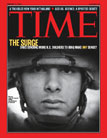Start of the year is a good time for forecasts. While there are many lists doing the rounds, here is one that I found most relevant.
At the start of the new year Folio: Alert once again brings us industry professionals' predictions for what 2007 might bring. Here are some trends culled from their long article:
1) Tipping point to digital2007 will be tipping point for traditional (ink on paper) publishers regarding their legacy business. The market is already punishing traditional publishing companies with lower valuations than multi-platform media companies command. In 2007 traditional publishing companies will be more focused than ever on adding online, television, events, etc. in order to preserve and build enterprise value.
Clay B. Hall, CEO, Aspire Media
...........................................................a. Magazines will expand their footprint into digital platforms, building audiences, creating bold new forms of content, and increasing ad revenues.
b. At the same time, more web-originating entities will find launching print magazines as the next logical step to creating deeper communities and a new revenue stream. (WebMD and TheKnot are sterling examples of successful web-to-print launches.)
c. Print magazines will maintain their hold on media advertising spending share, and will still be considered the premiere medium of engagement.
Nina Link, President & CEO, Magazine Publishers of America
2) B-2-B remains stronga.) The b-to-b media M&A market will remain strong. Look for at least one blockbuster b-to-b media deal in 2007.
b) 2006 has demonstrated the importance of transitioning print brands to the web as the key to the very survival of many magazines. Most consumer and b-to-b magazine publishers understand the importance of this secular change in the industry, but fewer will be successful in making the transition.
c.) Well positioned and well managed magazine brands will demonstrate surprising growth and profits in 2007. Savvy financial investors will see value opportunities that strategic players overlook. We will not experience a media recession in 2007.
Thomas Kemp, Managing Director, Verona Suhler Stevens
3) New Rules of the Gamea) The migration of dollars to online from print will pale in comparison to a far more detrimental effect for many publishers: the emergence of lead gen as the negotiating tool. Readership quality will be determined more by its ability to produce a lead than anything else.
b) Integrated Marketing Programs will be the best way to get the attention of clients. Sellers who are not strategic will be commoditized and driven to the bottom on price. Yet another unfortunate reality of the online emergence for those who dont have the right stuff.
Traver Hutchins, CEO, MediZine4) Emergence of Brands
Magazines will remain a healthy slice of the media landscape, and will grow more robust as print companies wake up to the fact that they own BRANDS and begin to manage them in the way that their advertisers have long managed their brands.
Tom Beusse, President, Time4Media
5) More Creative AdvertisingMagazines will continue to be challenged by advertising partners to deliver full marketing services and capabilities that surround traditional print buys with various multi-media and experiential elements. Magazines that continue to meet these challenges in a creative way, that is also mutually beneficial to all parties, will be the success stories of 2007.
Andy Cohn, Publisher, The Fader6) More Small Titles; Content emerges Differentiator
a) There will be more new analog printed titles than ever before, but with smaller and smaller circulations. There will be increased focus on Web social networking platforms for publishers and their readers.
b) Publishers will finally realize that content is their true franchise, anti-disregardless of the platform that content is distributed upon, and that we are entering the new golden age of profitable Information Distribution, formally known as publishing.
Bob Sacks, The Precision Media Group7) Ousourcing, other ways to Increase Revenuesa. A few months ago we saw VNU turn its back on ethics and begin inserting ads in editorial copy. After folks complained, VNU pulled back. I expect more of this. The pressure to increase revenue is enormous and a myth has arisen that the old rules don't apply in new media.
b. 2007 will also be the year of outsourcing. A number of magazines are already experimenting with having their art and design work done overseas. And Reuters opened the door in 2006 to outsourcing some editorial operations to India. But this movement will grow tremendously in 2007. The most likely scenario is that one of the dozens of magazines that have launched overseas editions in Vietnam, China, India and elsewhere will ask their overseas staff to take over U.S.-focused beats.
Paul Conley, Blogspot
8) Growth of FREE Titles
a. Buyers will finally realize that the cash flow from free distribution titles (non-requested) is just as good as the cash flow from requested or paid titles.
b) Hot Sectors? Follow the ad pages.
Drew Lawler, Managing Director, AJ LAWLER Partners9) Sponsor-supported PublishingAssociations will dramatically increase their sponsor-supported publishing. With new fee-for- service revenue harder than ever to get, with ad pages falling in some areas, and with association members wanting ever more detail to meet professional challenges, sponsor-supported publishing makes sense, as long as appropriate controls are in place to ensure the content retains the objectivity that is core to an associations value.
Robert Fromberg, President, Society of National Association Publications
10) Demand for better circulation metrics
As publishers extend their brands into other media platforms, there will be a greater demand for developing new reporting and metrics reflective of the changing media consumption habits of traditional and new readers. Although they may not be directly comparable, Web and circulation metrics together can demonstrate a publications brand and the reach of its content. As media silos are reduced or eliminated by advertisers, their demand for consolidated accountability across all media platforms will find publishers and ABC providing new tools to address their needs.
Michael J. Lavery, President and Managing Director, ABC
--------------------------------------------------- -----------------------------
This is a highly condensed list. You can read the complete one
hereLabels: Article
 With its February 2007 issue Wired magazine has a new look, starting with a tweaked logo/masthead. According to a post on Wired news, ‘the redesign is based on a simple premise: expand the use of provocative photography and inventive illustration while maintaining the tradition of innovative typography and design pioneered by John Plunkett in 1993’.
With its February 2007 issue Wired magazine has a new look, starting with a tweaked logo/masthead. According to a post on Wired news, ‘the redesign is based on a simple premise: expand the use of provocative photography and inventive illustration while maintaining the tradition of innovative typography and design pioneered by John Plunkett in 1993’. New Masthead: Refer to the new cover (large image on top)and older cover (small image to the right)
New Masthead: Refer to the new cover (large image on top)and older cover (small image to the right)






